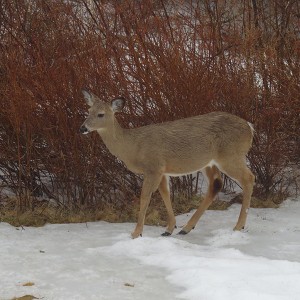I had a surprise visitor in my yard yesterday evening.
I’m lucky to have lots of wildlife show up outside my window but the deer don’t usually get this close. The lingering snow this year has them wandering outside their usual zones to find tasty tidbits.
I love trying to get pictures of wildlife whether at home or during travels. (The image in the banner is of a dock cat at a nearby fishing community.) If animals are also on your list of interests, you might like some of these tips for catching pets or animals in the wild.
Tips for strong wildlife photos
- Take your time. Try to get the animal in a relaxed state and comfortable surroundings. Since it is hard to get [most] pets to pose, capture them at play or work.
- Be patient. Sometimes a slight turn of the head or other movement by the subject will create a more dramatic image.
- Use natural light when possible. For an indoor shoot, try to have your pet in front of a window with lots of natural available light. Avoid harsh, direct light. Shaded areas or overcast skies work best.
- If you must use a flash, try to avoid catching the animal looking directly at the light to minimize unnatural (even spooky) “green (or red) eye”.
- Shoot wild animals in their natural environment.
- Zoom in close on faces. Focus on eyes as you would in portrait photography.
- Vary the distance to get some wide shots to provide context as well as close shots.
- Try some three quarter angle shots as well as ones from the front.
- Bracket your exposure, especially with an animal that is very dark or very light. Take multiple pictures with different settings.
- Get a new perspective – get down low to their level or shoot from above for a different angle.
- Consider bringing along an assistant that will hold or call your pet – or distract the wild animal.
- Do not feed or disturb a wild animal. A notable exception to this is leaving summer growth or cut trees and branches for winter food or hiding places. Putting birdseed is also recommended in many areas, especially for small birds overwintering in cold climates.
I’d love to hear your stories of animal photography triumphs and /or missed opportunities. Or any tips you have discovered. Share in the comments.


0 Comments